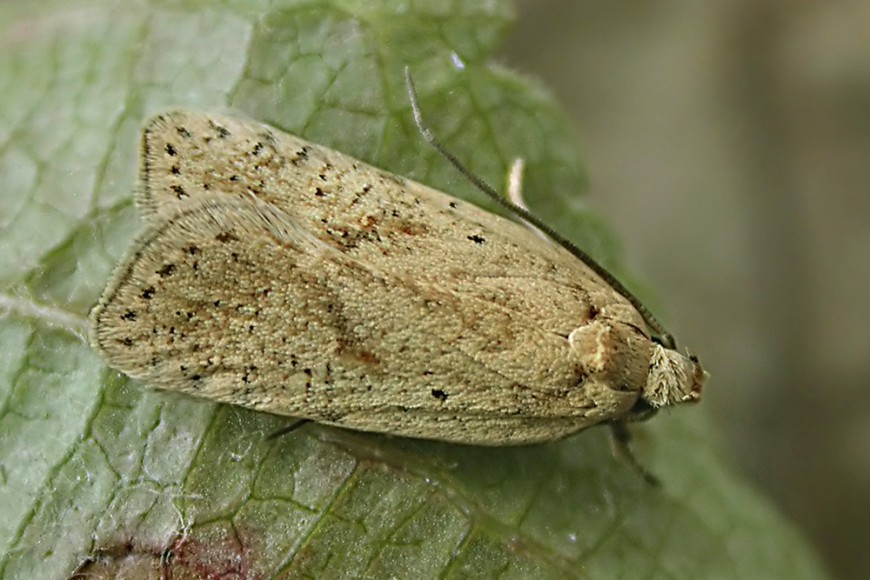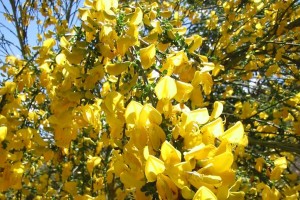Broom shoot moth

Image: broom shoot moth (Agonopterix assimilella). Photo credit: Charlie Streets via Charlie's Moths of Calderdale.
History in New Zealand
The broom shoot moth is native to Western Europe and was first imported in 2006 by Manaaki Whenua - Landcare Research on behalf of the Canterbury Broom Group. This agent was first released in 2007. The wide distribution of this moth in its native range, across a range of climatic types, suggests that it could establish wherever broom occurs in New Zealand, however it may perform best at colder, high-altitude sites.
How would I find them?
The adult moths are about 10 mm long and pale brown in colour – the wings are stippled with some darker spots. You are unlikely to see the moths as they are nocturnal. Look instead for the caterpillars. Small caterpillars are dark-brown and they become dark-green as they mature. In spring, caterpillars emerge from stems, where they have hibernated over winter, and make themselves a tent, by tying together a couple of twigs with webbing. Caterpillars use this tent as base for foraging on broom leaf material. They take 3–4 months to develop and will be easiest to see in late spring.
Image: broom shoot moth caterpillar.
Once fully grown, the caterpillars pupate for 2–4 weeks in the soil.

Image: broom shoot moth pupae.
Adults are long-lived and newly emerged adults aestivate (summer hibernate) for several weeks before they begin to lay eggs in early autumn. After hatching, the tiny caterpillars bore into the stems for winter.

Image: broom shoot moth egg.
This agent is closely related and similar in appearance and action to the gorse soft shoot moth (Agonopterix ulicetella) which is found on gorse. Occasionally, leafrollers attack broom, but they are easy to distinguish from broom shoot moth caterpillars as they are usually much lighter green, and they only cause minor damage. The broom shoot moth is also easy to differentiate from other broom agents.
See Broom gall mite, Broom leaf beetle, Broom seed beetle, Broom psyllid, Broom twig miner, and Gorse soft shoot moth.
How do they damage broom?
The damage is caused by the caterpillars which feed on the leaves and can sometimes kill off stem tips and small branches by ring-barking them. In conjunction with the broom leaf beetle (Gonioctena olivacea), they can sometimes strip plants bare, so that no green growth is left above ground.
Will they attack other plants?
While broom is the preferred host, it is possible that the broom shoot moth may attack tree lucerne (Cytisus proliferus) to a much lesser extent, and it occasionally may attack ornamental brooms (Cytisus spp.), Montpellier broom (Genista monspessulana), Spanish broom (Spartium junceum), tree lupin (Lupinus arboreus) and Russell lupin (Lupinus polyphyllus). The Environmental Risk Management Authority approved the release of this agent, despite some possible non-target attack, because of the serious threat that broom poses.
How effective are they?
Although there have been a handful of sightings, we do not have clear evidence that the broom shoot moth is well established in New Zealand.
How can I get the most out of this agent?
As soon as shoot moths are present in harvestable numbers, it would be worth helping to establish them in all areas where they are needed.
How do I select a release site?
Read Guidelines for selecting release sites for biocontrol agents.
How do I collect them for release at other sites?
Harvest branches with webs on them or whole bushes in late spring when large caterpillars or pupae are present. Shift at least several hundred webs to each new site. Wedge the infested material firmly into broom bushes at the new release sites.
How do I manage the release sites?
Avoid any activities that will interfere with the moths, such as herbicide application. If you need to undertake control measures, then avoid the release site.
